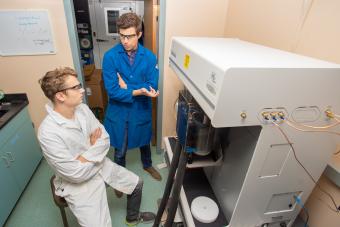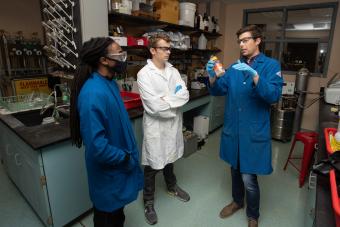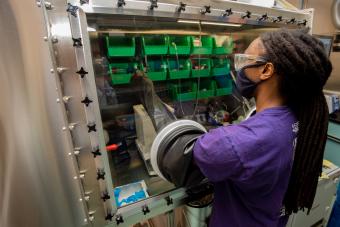Mines researchers dig into carbon capture, utilization and storage technologies
First-of-its-kind online graduate certificate is also preparing working engineers to take on challenge of CCUS

Michael McGuirk, assistant professor of chemistry, right, is among the Mines faculty members digging in to the challenge of carbon capture, utilization and storage. His research group is currently looking at ways to capture carbon with earth abundant salts called metal oxides. (Photos by Joe DelNero/Colorado School of Mines)
By Jenn Fields, Special to Mines Newsroom
As more businesses commit to net zero emissions by 2050 and new legislation paves the way for investments in carbon capture, utilization and storage, Colorado School of Mines researchers are digging deeper into CCUS technologies that will meet real-world needs. And with the launch of a new three-course graduate certificate program in CCUS at Mines, working engineers will be well prepared to take on the challenge.
“A lot of the push is coming from the industry side,” John Bradford, vice president of global initiatives at Mines, said of global CCUS efforts. “Governments and corporations are all trying to set 2050 as a goal to try to hit net zero. If we set that as a goal, great, but let’s recognize that we’re going to need CCUS. As a society, we have to get there, and there are all sorts of technical and policy barriers.”
“Our goal is to be the premier institution on research and education on CCUS,” he said. “We have the ties with industry, and we have a solution-focused mindset at Mines.”
The new graduate certificate, which is designed to give engineers a better understanding of how CCUS works and how to implement these nascent technologies, began this fall. “The goal is to offer education on the carbon cycle and climate change, geologic and non-geologic storage and capture—that’s primarily in chemistry—and then economics and policy,” Bradford said. By tapping Mines’ expertise in engineering, geology and policy, the online certificate will provide a deep dive into CCUS technologies that participants will be able to apply immediately on a professional level.
The basic idea behind carbon capture has been around, and even in limited use, for a few decades: Scrub greenhouse gases such as carbon dioxide out of an emissions source before it hits the air. Now, researchers are working on a mix of solutions, to capture carbon at the source or even snagging it straight out of the air.
Since existing carbon capture technologies aren’t in widespread use—either because they’re not scalable or cost-effective—billionaires, business and government are upping the ante on finding CCUS technology that solves those issues. A bipartisan bill in the U.S. Senate calls for increasing the price per ton on the tax credit companies can take for sequestering and storing carbon. Business magnate Elon Musk offered up $100 million for a carbon-capture contest earlier this year, and Exxon Mobil, which plans to eventually rely on CCUS to achieve its emissions goals, started a new business unit focused on developing and commercializing CCUS.
“Pretty much every oil and gas company is investing in CCUS,” Bradford said.
“There’s a lot of momentum right now,” said Laura Singer, program manager for the Mines CCUS Initiative. The initiative launched in 2020 to bring together more than 40 researchers at Mines who were already working on carbon capture in fields as varied as bioengineering, economics and chemistry. “The work that is going on at Mines has been happening for a long time already, but it was siloed in different departments instead of into an integrated approach,” Singer said.
Pricing carbon
Singer, whose work is in economics and policy, said developing an economy around carbon will be critical to driving down the cost. “Without a real price on carbon, companies aren’t going to opt to start doing this until they can make a profit out of it in some way,” she said.
Cost has consistently been a prohibitive issue with CCUS. Last year, a coal-fired power plant in Texas that had been capturing its carbon shut down, unable to recoup the costs of the project. Though coal is in decline as a power source in the U.S., building on what was learned from the Petra Nova plant is still important, Singer said. “That kind of technology is going to be critical for countries that are still building coal plants. There’s a real benefit to the U.S. leading on this kind of technology so we can export it.”
And once carbon dioxide is captured, industry will need customers who can use it. “The singular demand for CO2 has been for enhanced oil recovery,” Singer said. “But EOR won’t be enough to support the scale of carbon capture that’s needed to stabilize the climate. However, as more utilization projects for CO2 ramp up—curing concrete, putting it in cement, producing biochar, you can use it for beverages—demand will increase. Right now, it’s kind of niche, because it’s expensive. There needs to be an incentive, such as a price on CO2, to drive investment in these technologies.”
Congress has been working on policy solutions for several years, including the 45Q tax credit, and the energy bill passed by Congress in December 2020 included $6 billion for investment in carbon capture and geologic storage over the next five years. “Congress affirmed their commitment to this technology. It’s going to be critical to achieving climate goals at 1.5 or 2 degrees Celsius,” Singer said, referring to the goals of the 2015 Paris Agreement.
Capturing carbon with methane-eating bacteria and “biobricks”
One of the reasons one particular method of CCUS technology hasn’t taken off yet is that heavy industry and the energy sector have such a variety of capture needs. “There is a diversity of sources of CO2 emissions, and each one is a complex mixture of gases,” said Michael McGuirk, assistant professor of chemistry. “Because of that, there probably won’t be a singular solution. These are things that constantly need redevelopment and adaptation for each specific situation.”
Fortunately, the momentum around CCUS solutions is helping fund research projects in virtually all STEM fields.
“The technology is at a point where we’re ready to explore these really cool ideas,” said Nanette Boyle, Coors Developmental Chair and associate professor of chemical and biological engineering. Boyle is on a three-year fellowship with Scialog that brings researchers into multidisciplinary teams to find solutions in negative emissions science.
In one of her projects, Boyle is collaborating with Chong Liu at UCLA on research in methane-eating cyanobacteria. “We’re trying to get organisms that naturally eat methane to do it at a faster rate,” she said. Capturing methane is a challenge, but it’s the sort of high-risk, high-reward project the fellowship is designed to encourage. “Methane is in two parts per million concentration in the air, which is much, much, much lower than carbon dioxide, but it has a much greater effect on greenhouse gasses, so it’s 30 times more potent as a greenhouse warming gas,” she said. “And it’s hard to capture because it’s in much lower concentrations.”
For her other Scialog project, Boyle and Yale’s Shu Hu are working together to alter the pH of ocean water so it becomes super saturated with carbon from the atmosphere, then using cyanobacteria to cause precipitation of the carbon dioxide. The precipitated calcium carbonate can then be used in concrete, essentially making a sustainably sourced “biobrick.” “The cyanobacteria are giving off carbon, and that will cause the other carbon in the ocean water to fall out of solution,” she said. “That’s how we’re going to collect it, and you can use that carbonate as a starting point for concrete—hence the ‘biobrick.’”

McGuirk is working with Ryan Richards, professor of chemistry, on capturing carbon with earth abundant salts called metal oxides.
“Carbon capture has been around a really long time,” McGuirk said. “But the technology that’s been developed, called aqueous amines, is basically a bath of water with an amine in it, and the amine reacts with CO2 really well, but to get the CO2 out, you have to heat the bath up, and that makes the whole process really inefficient. Efforts to get around this inefficiency focus on solid materials, because it uses much less energy to heat it up.”
“The hard part is that you don’t want to use your material just once,” he said. “You need to be able to regenerate it and recycle it. So, you need something that grabs the CO2 strongly, and once you grab it, you need to be able to release the CO2. We’re trying to develop those adsorbents that can capture CO2 and also release it in a way that doesn’t expend a lot of energy.”
In his research with Richards, McGuirk’s team is looking at ways to apply carbon capture in metal oxides to a variety of situations, from direct air capture to capturing at the source when burning coal and natural gas.
“What we know now is that this material can capture CO2,” he said. “Now what we’re trying to understand is, can we tune how well it captures it, and can we tune the energetic requirements to get the CO2 back off?”





